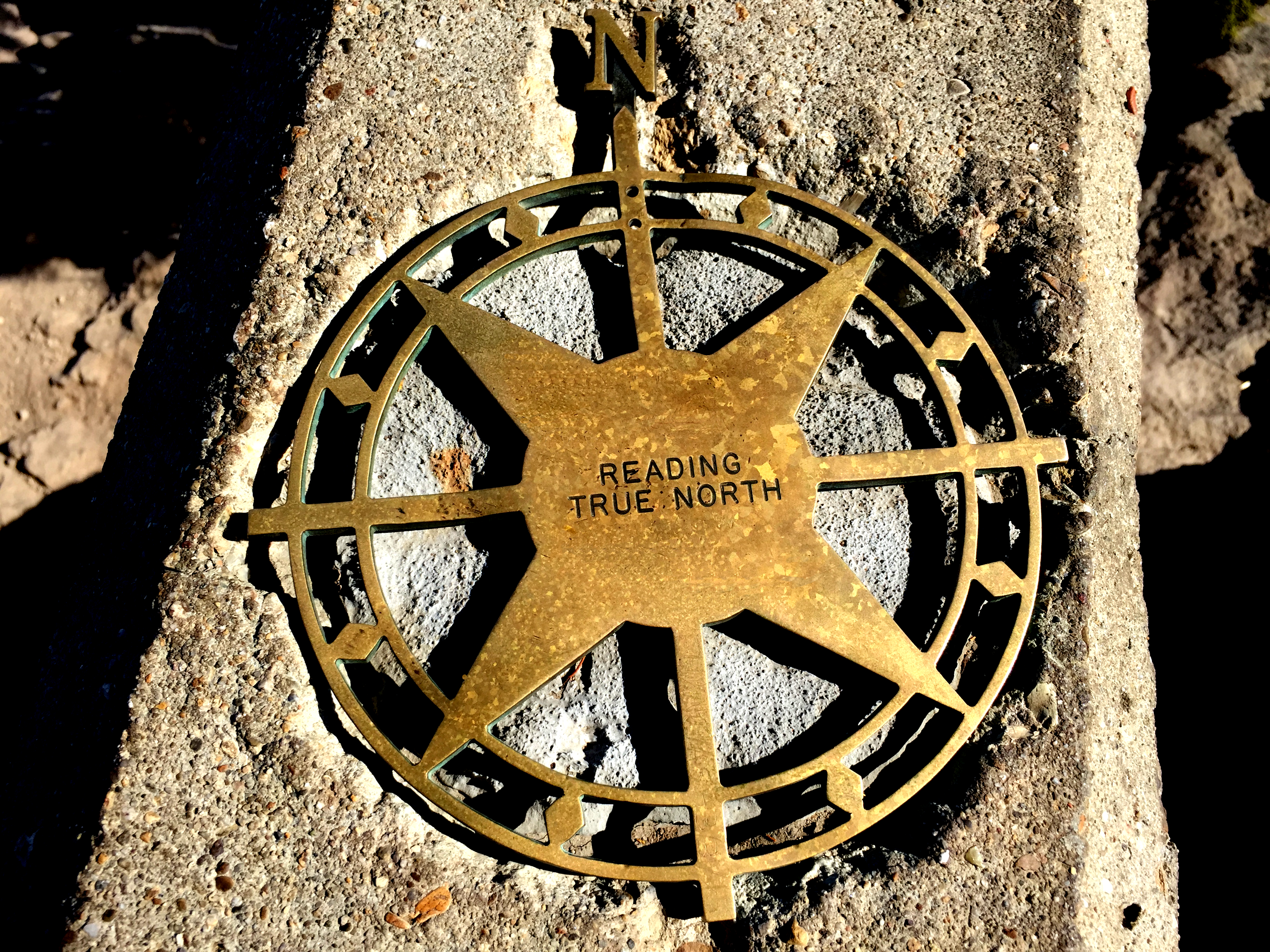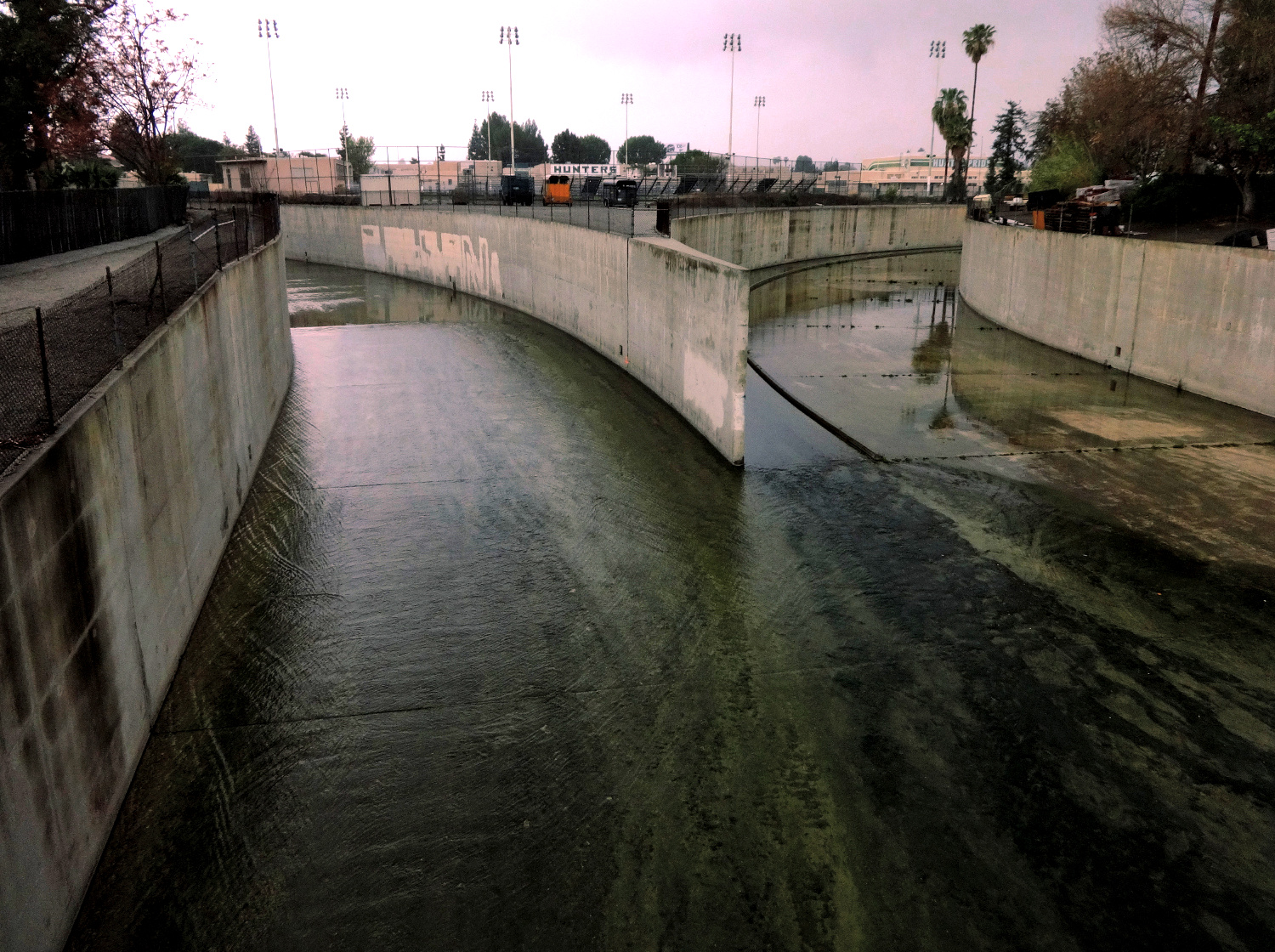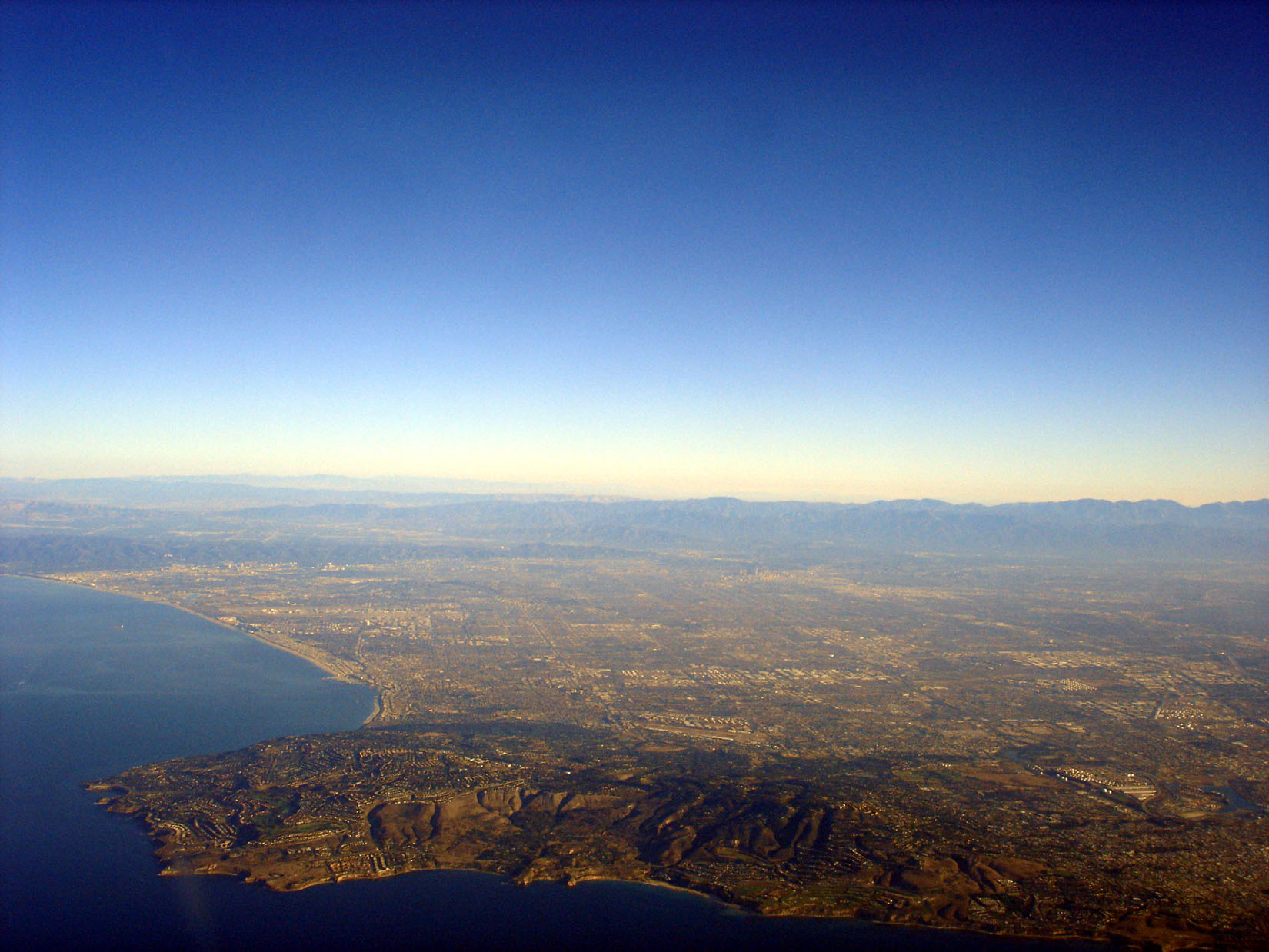|
Santa Monica Mountains
The Santa Monica Mountains is a coastal mountain range in Southern California, next to the Pacific Ocean. It is part of the Transverse Ranges. Because of its proximity to densely populated regions, it is one of the most visited natural areas in California. The Santa Monica Mountains National Recreation Area encompasses this mountain range. Geography The range extends approximately east-west from the Hollywood Hills in Los Angeles to Point Mugu in Ventura County. The western mountains, separating the Conejo Valley from Malibu, suddenly end at Mugu Peak as the rugged, nearly impassible shoreline gives way to tidal lagoons and coastal sand dunes of the alluvial Oxnard Plain. The mountain range contributed to the isolation of this vast coastal plain before regular transportation routes reached western Ventura County. The eastern mountains form a barrier between the San Fernando Valley and the Los Angeles Basin, separating "the Valley" on the north and west-central Los Angeles ... [...More Info...] [...Related Items...] OR: [Wikipedia] [Google] [Baidu] |
Malibu Canyon
Malibu Creek is a year-round stream in western Los Angeles County, California. It drains the southern Conejo Valley and Simi Hills, flowing south through the Santa Monica Mountains, and enters Santa Monica Bay in Malibu, California. The Malibu Creek watershed drains and its tributary creeks reach as high as into Ventura County, California. The creek's mainstem begins south of Westlake Village at the confluence of Triunfo Creek and Lobo Canyon Creek, and flows U.S. Geological Survey. National Hydrography Dataset high-resolution flowline dataThe National Map, accessed March 16, 2011 to Malibu Lagoon. Malibu Canyon is a chief pass through the mountains, and Malibu Canyon Road is a major north/south route connecting the coast to the inland valley. Malibu Creek starts at Malibou Lake, which is held back by the Malibu Lake Dam. Further downstream, the creek waterfalls over the Rindge Dam, then carves its final path into Malibu Lagoon. History The area around Malibu Creek was for c ... [...More Info...] [...Related Items...] OR: [Wikipedia] [Google] [Baidu] |
Tidal Estuary
An estuary is a partially enclosed coastal body of brackish water with one or more rivers or streams flowing into it, and with a free connection to the open sea. Estuaries form a transition zone between river environments and maritime environments and are an example of an ecotone. Estuaries are subject both to marine influences such as tides, waves, and the influx of saline water, and to fluvial influences such as flows of freshwater and sediment. The mixing of seawater and freshwater provides high levels of nutrients both in the water column and in sediment, making estuaries among the most productive natural habitats in the world. Most existing estuaries formed during the Holocene epoch with the flooding of river-eroded or glacially scoured valleys when the sea level began to rise about 10,000–12,000 years ago. Estuaries are typically classified according to their geomorphological features or to water-circulation patterns. They can have many different names, such as bays, harbo ... [...More Info...] [...Related Items...] OR: [Wikipedia] [Google] [Baidu] |
Chumash People
The Chumash are a Native American people of the central and southern coastal regions of California, in portions of what is now San Luis Obispo, Santa Barbara, Ventura and Los Angeles counties, extending from Morro Bay in the north to Malibu in the south. Their territory included three of the Channel Islands: Santa Cruz, Santa Rosa, and San Miguel; the smaller island of Anacapa was likely inhabited seasonally due to the lack of a consistent water source. Modern place names with Chumash origins include Malibu, Nipomo, Lompoc, Ojai, Pismo Beach, Point Mugu, Port Hueneme, Piru, Lake Castaic, Saticoy, Simi Valley and Somis. Archaeological research demonstrates that the Chumash people have deep roots in the Santa Barbara Channel area and lived along the southern California coast for millennia. History Prior to European contact (pre-1542) Indigenous peoples have lived along the California coast for at least 11,000 years. Sites of the Millingstone Horizon date fro ... [...More Info...] [...Related Items...] OR: [Wikipedia] [Google] [Baidu] |
Tongva People
The Tongva ( ) are an Indigenous people of California from the Los Angeles Basin and the Southern Channel Islands, an area covering approximately . Some descendants of the people prefer Kizh as an endonym that, they argue, is more historically accurate. In the precolonial era, the people lived in as many as 100 villages and primarily identified by their village rather than by a pan-tribal name. During colonization, the Spanish referred to these people as Gabrieleño and Fernandeño, names derived from the Spanish missions built on their land: Mission San Gabriel Arcángel and Mission San Fernando Rey de España. ''Tongva'' is the most widely circulated endonym among the people, used by Narcisa Higuera in 1905 to refer to inhabitants in the vicinity of Mission San Gabriel. Along with the neighboring Chumash, the Tongva were the most influential people at the time of European encounter. They had developed an extensive trade network through '' te'aats'' (plank-built boats). ... [...More Info...] [...Related Items...] OR: [Wikipedia] [Google] [Baidu] |
:Category:Native American History Of California
*The history of the Indigenous peoples of California. ::::*For individual tribal histories, see articles & tribal subcategories in: : Native American tribes in California ---- ::*Individual indigenous people of California (historical & contemporary) are in the category for their relevant tribe/people, found in: : Native American tribes in California. ::*Indigenous Californian languages (historical & contemporary) are in: : Indigenous languages of California. ::*California Indian reservations (historical & contemporary) are in: : American Indian reservations in California. ::*California tribes (historical & contemporary) are in: : Native American tribes in California. ::*Ongoing topics (contemporary or not only historical) are in: : Indigenous peoples of California topics. ::::*''Labeled map (external link)Map of Native Tribes, Groups, Language Families, and Dialects of California region in 1770'. History History California California is a state in the Weste ... [...More Info...] [...Related Items...] OR: [Wikipedia] [Google] [Baidu] |
Archeology
Archaeology or archeology is the scientific study of human activity through the recovery and analysis of material culture. The archaeological record consists of Artifact (archaeology), artifacts, architecture, biofact (archaeology), biofacts or ecofacts, archaeological site, sites, and cultural landscapes. Archaeology can be considered both a social science and a branch of the humanities. It is usually considered an independent academic discipline, but may also be classified as part of anthropology (in North America – the four-field approach), history or geography. Archaeologists study human prehistory and history, from the development of the first stone tools at Lomekwi in East Africa 3.3 million years ago up until recent decades. Archaeology is distinct from palaeontology, which is the study of fossil remains. Archaeology is particularly important for learning about prehistoric societies, for which, by definition, there are no written records. Prehistory includes ove ... [...More Info...] [...Related Items...] OR: [Wikipedia] [Google] [Baidu] |
Elysian Park
Elysian Park is one of the largest parks in Los Angeles at 600 acres (240 ha). Most of Elysian Park falls in the neighborhood of the same name, but a small portion of the park falls in Echo Park. The park was created by city ordinance on April 5, 1886. City engineer George Hansen sponsored the ordinance. The land was considered "worthless" at the time. At the time, only a few other parks existed within the Los Angeles city limits. For some time the land sat unimproved, but eventually roads, trails, and landscaping was added. Parts of Elysian Park were swapped for other lands held by the Los Angeles Dodgers The Los Angeles Dodgers are an American professional baseball team based in Los Angeles. The Dodgers compete in Major League Baseball (MLB) as a member club of the National League (NL) West division. Established in 1883 in the city of Brookl ... when Dodger Stadium was built. Notable features Angels Point is a small hill in Elysian Park overlooking Dodger Stadium an ... [...More Info...] [...Related Items...] OR: [Wikipedia] [Google] [Baidu] |
Los Angeles River
, name_etymology = , image = File:Los Angeles River from Fletcher Drive Bridge 2019.jpg , image_caption = L.A. River from Fletcher Drive Bridge , image_size = 300 , map = LARmap.jpg , map_size = 300 , map_caption = Map of the Los Angeles River watershed , pushpin_map = , pushpin_map_size = , pushpin_map_caption= , subdivision_type1 = Country , subdivision_name1 = United States , subdivision_type2 = State , subdivision_name2 = California , subdivision_type3 = , subdivision_name3 = , subdivision_type4 = , subdivision_name4 = , subdivision_type5 = Cities , subdivision_name5 = Burbank, Glendale, Los Angeles, Downey, Compton, Long Beach , length = U.S. Geological Survey. National Hydrography Dataset high-resolution flowline dataThe National Map, accessed 2011-05-07 , width_min = , width_avg = , width_max = , depth_min ... [...More Info...] [...Related Items...] OR: [Wikipedia] [Google] [Baidu] |
Parallel (geometry)
In geometry, parallel lines are coplanar straight lines that do not intersect at any point. Parallel planes are planes in the same three-dimensional space that never meet. ''Parallel curves'' are curves that do not touch each other or intersect and keep a fixed minimum distance. In three-dimensional Euclidean space, a line and a plane that do not share a point are also said to be parallel. However, two noncoplanar lines are called '' skew lines''. Parallel lines are the subject of Euclid's parallel postulate. Parallelism is primarily a property of affine geometries and Euclidean geometry is a special instance of this type of geometry. In some other geometries, such as hyperbolic geometry, lines can have analogous properties that are referred to as parallelism. Symbol The parallel symbol is \parallel. For example, AB \parallel CD indicates that line ''AB'' is parallel to line ''CD''. In the Unicode character set, the "parallel" and "not parallel" signs have co ... [...More Info...] [...Related Items...] OR: [Wikipedia] [Google] [Baidu] |
Los Angeles Basin
The Los Angeles Basin is a sedimentary Structural basin, basin located in Southern California, in a region known as the Peninsular Ranges. The basin is also connected to an wikt:anomalous, anomalous group of east-west trending chains of mountains collectively known as the Transverse Ranges. The present basin is a coastal lowland area, whose floor is marked by elongate low ridges and groups of hills that is located on the edge of the Pacific Plate. The Los Angeles Basin, along with the Santa Barbara Channel, the Oxnard Plain, Ventura Basin, the San Fernando Valley, and the San Gabriel Valley, San Gabriel Basin, lies within the greater southern California region. On the north, northeast, and east, the lowland Drainage basin, basin is bound by the Santa Monica Mountains and Puente, Elysian, and Repetto hills. To the southeast, the basin is bordered by the Santa Ana Mountains and the San Joaquin Hills. The western boundary of the basin is marked by the Continental Borderland and is ... [...More Info...] [...Related Items...] OR: [Wikipedia] [Google] [Baidu] |
San Fernando Valley
The San Fernando Valley, known locally as the Valley, is an urbanized valley in Los Angeles County, California. Located to the north of the Los Angeles Basin, it contains a large portion of the City of Los Angeles, as well as unincorporated areas and the incorporated cities of Burbank, Calabasas, Glendale, Hidden Hills, and San Fernando. The valley is well known for its iconic film studios such as Warner Bros. Studio and Walt Disney Studios. In addition, it is home to the Universal Studios Hollywood theme park. Geography The San Fernando Valley is about bound by the Santa Susana Mountains to the northwest, the Simi Hills to the west, the Santa Monica Mountains and Chalk Hills to the south, the Verdugo Mountains to the east, and the San Gabriel Mountains to the northeast. The northern Sierra Pelona Mountains, northwestern Topatopa Mountains, southern Santa Ana Mountains, and Downtown Los Angeles skyscrapers can be seen from higher neighborhoods, passes, roads, and ... [...More Info...] [...Related Items...] OR: [Wikipedia] [Google] [Baidu] |
Coastal Plain
A coastal plain is flat, low-lying land adjacent to a sea coast. A fall line commonly marks the border between a coastal plain and a piedmont area. Some of the largest coastal plains are in Alaska and the southeastern United States. The Gulf Coastal Plain of North America extends northwards from the Gulf of Mexico along the Lower Mississippi River to the Ohio River, which is a distance of about . The Atlantic Coastal Plain runs from the New York Bight to Florida. The Coastal Plains of India lie on either side of the Deccan Plateau, along the western and eastern coasts of India. They extend for about 6,150 km from the Rann of Kutch in the west to West Bengal in the east. They are broadly divided into the Western Coastal Plains and the Eastern Coastal Plains. The two coastal plains meet at Kanyakumari, the southernmost tip of the Indian mainland. The eastern coastal plain is located between The Bay of Bengal and the eastern Ghats and the western coastal plain is located betwee ... [...More Info...] [...Related Items...] OR: [Wikipedia] [Google] [Baidu] |




.jpg)


.png)

